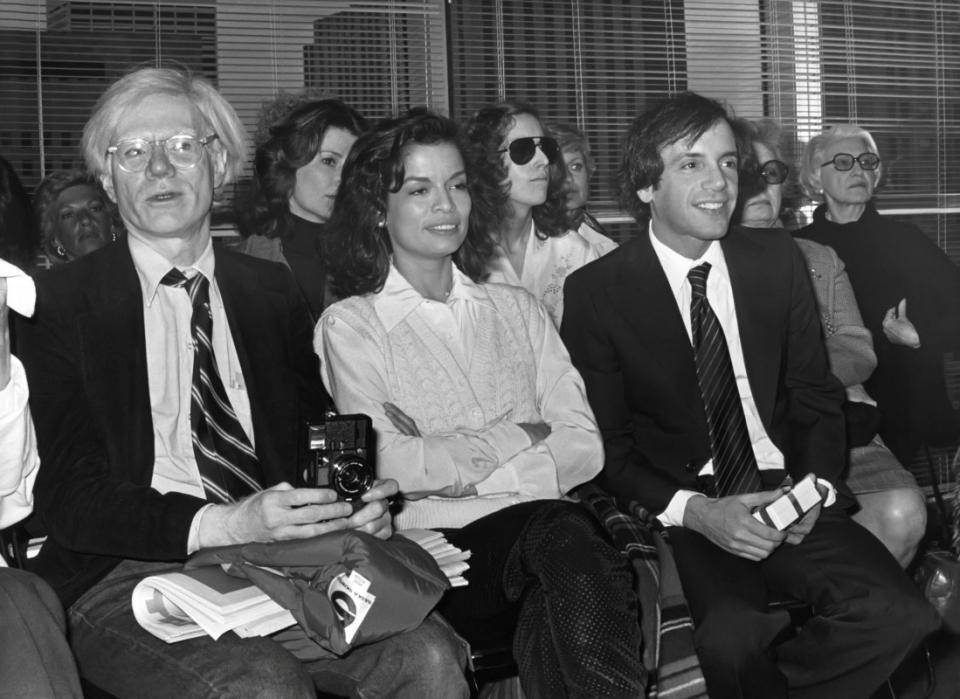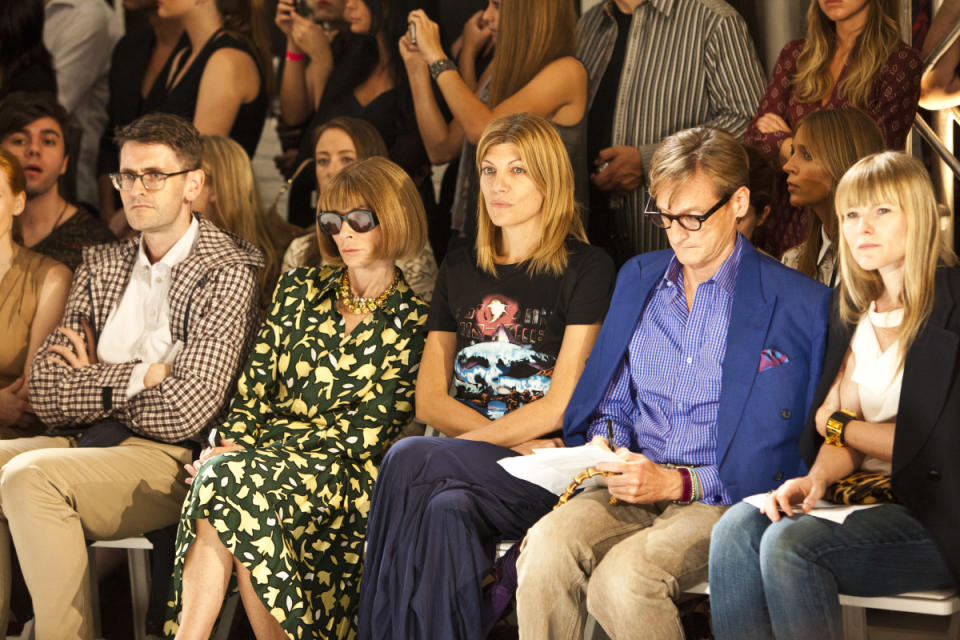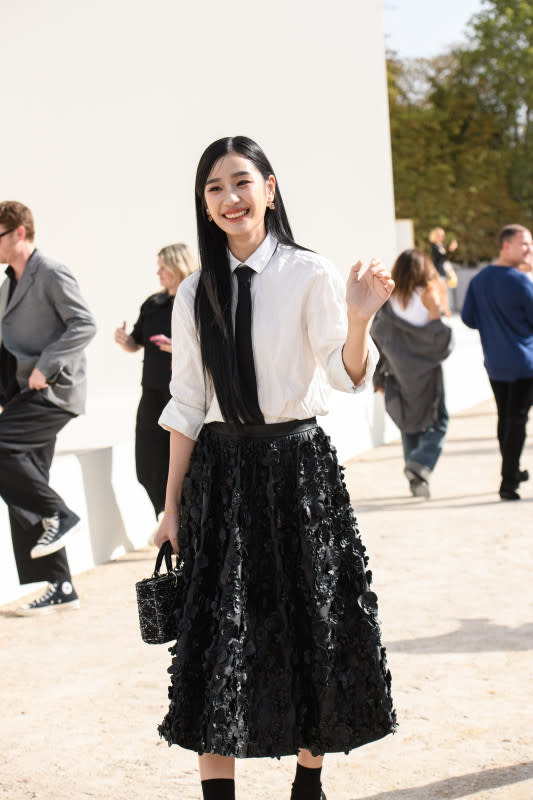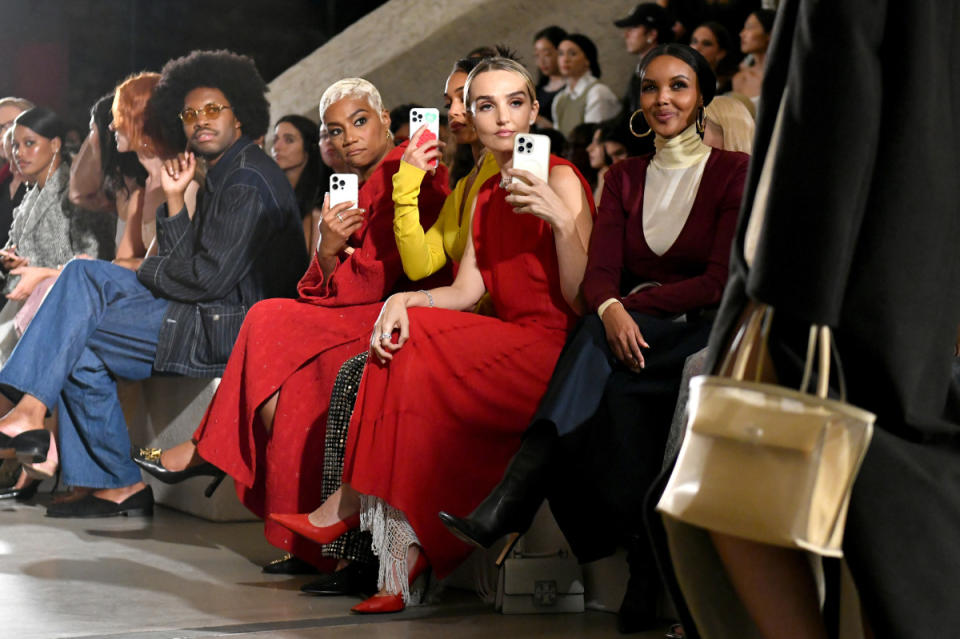The Art of the Front Row: How VIP Seating Moves the Needle
- Oops!Something went wrong.Please try again later.
For as long as fashion shows have existed, guest lists — and, in particular, front rows — have helped define the standing of a brand or designer.
Even pre-social media, when fashion week retained a special mystique and degree of secrecy, front rows served as barometers of the cultural zeitgeist. At one of Christian Dior's earliest shows, for example, French surrealist icon Jean Cocteau and American socialite Wallis Simpson sat alongside journalists; in the '70s, Bianca Jagger was a frequent VIP guest, often placed between Studio 54 owner Steve Rubell and pop-art pioneer Andy Warhol.
Over the years, front rows have remained a reunion of motley personalities across fields, but the dynamics and purpose of them have evolved. Magazine editors, digital editors, buyers, celebrities and, increasingly, content creators come together to assess, support and promote new collections. But today, more than ever, the front row has become a stage on its own, says creative and digital strategist Laurent François, managing partner at the creative agency 180 Global.
"Front row is more than ever a social marker. What used to be an elitist and fairly discrete access has become an entertainment platform," he explains. "Before, the front row was content you would find on celebrity pages of main magazines. Now, the fashion show narrative structure has changed. The protagonists are not just the models on the catwalks, but [also] the attendees, who have a part to play; the storyline starts far before the live show, and lasts longer."

Photo: Images Press/IMAGES/Getty Images
Jordan Frazes, founder of partnerships agency Frazes Creative (working with Latin American powerhouses like Sebastián Yatra, Nathy Peluso and Nicki Nicole) echoes the idea that front-row guests are an increasingly important piece of the fashion show puzzle: "The fashion is on display and will be captured, but it's the famous faces in the background, their styling and sometimes their facial expressions that make their way into the headlines of media coverage."
With these new actors breaking into the fashion scene — not as observers, but as key players — crafting a seating chart has become an art form in itself, says Gia Kuan, founder of Gia Kuan Consulting, the global consultancy representing well-loved brands such as Kim Shui and Telfar. "There's no cookie-cutter solution" to curating a guest list, she argues. Many factors come into play, from logistical limitations to brand goals.
"We need to consider the brand's ethos and where they are or where they want to be in terms of milestones," she ponders. "Is it a community-heavy brand where we value the presence of their direct-end consumer types or collaborators, or are we prioritizing press and industry/buyer models?"
The process of deciding who will be invited to a show is unique to each brand and PR team, but as front rows contribute to introducing novelty and raising anticipation for the event, organizers are often confronted with the challenging task of prioritizing certain guests. Decisions, however, will be discretional — and can even differ from one season to the other.

Photo: Skip Bolen/WireImage
Sometimes, brands would observe traditional industry practices, favoring senior fashion professionals, sponsors, legacy publication editors and those who are most likely to help the brand gain exposure and guarantee sales — namely stylists, buyers and brand ambassadors. Of course, there are only so many front-row seats in a given venue.
Matthew Cancel, founder and CEO of the public relations and creative agency Cancel Communications, starts with two main questions: "How is this collection going to be seen?" and "How is this collection going to be purchased?"
"It's not as simple as, 'Okay, let's invite editors and buyers' — it's understanding where customers are actually shopping and getting their information," he explains. "This is a big reason social media creators are now a large part of NYFW. They have the reach, they have an engaged audience and millions of people are only going to see certain runway shows through the lens of their channels."
"Sometimes there's the reality of a tighter space, and a second row is necessary," Kuan explains. "I know 'standard industry practices' are often prioritized by seniority within the industry and social clout — for us, it's about who has supported the brand and will continue to do so and [is] not just there to be seen, and that the support is coming from a genuine and consistent place. Sponsors are a large factor, if they have seats as part of deliverables."
Experts seem to agree that genuine support and community building are a priority.
"Every season we assess who's been supportive of the brand since the last show, who the client is excited about and what requests we've received inbound," says Lindsey Solomon, founder of Lindsey Media, one of New York's top fashion publicists. "I think [brands prioritize the type of guest] that's genuinely excited and wants to be present and isn't just requesting [a seat] for the sake of being there."
This reciprocity is also important for talent management.
"The ultimate goal is to create mutually beneficial partnerships that make both the artists and the brand shine," says Sataporn Panichraksapong, chief executive officer of GMMTV, the Thai company representing fashion's newest front-row sensations, from Prada ambassador Metawin Opas-iamkajorn (a.k.a. Win Metawin) to rising stars Jirawat Sutivanichsak (Dew) and Tu Tontawan, who've sat front row at Loewe and Dior shows, respectively.
"We'd say the key elements include checking if the brand vibes with the artist's image and values, making sure it connects with the target audience they're trying to reach," he adds. "The reputation of the fashion brand and the potential for a long-term relationship are also essential considerations.

Photo: Kirstin Sinclair/Getty Images
Though storytelling and connection between brands and show attendants is essential, there are additional aspects that'll determine the set-up of a front row, such as guest availability and the fast-paced nature of the industry. As Cancel puts it, the environment doesn't allow for brands to lock in front rows as far in advance as the general public would believe.
"VIPs' schedules are fickle, so they're constantly dropping out and need to be replaced with others," he says. This is especially true in February, when celebrities' schedules are packed with award-season obligations. "Typically, [preparations start] about six weeks before the show, with the real work happening in the last two weeks."
It's not just actors and musicians who can be hard to pin down: "The media industry is currently an absolute disaster, so it's very possible that if you invite an editor too early, they may not be working at that magazine come show time," he adds.
Last-minute confirmations, no-shows and cancellations also influence the arrangement of a first row. "We need to consider and predict drop off — it's math, some risk and guesswork," explains Kuan. "Given how compact the invitations schedule leading up to the shows is, seating is usually done the week leading up to show, with confirmations sent the day prior and changes all the way through to the day of show."

Photo: Lexie Moreland/WWD via Getty Images
In an era where part of the success of a fashion show is measured through metrics such as Media Impact Value (MIV), numbers will also be considered to some extent. Social media following, ability to attract audiences and brand exposure are factors that influence the configuration of VIP sections.
Nevertheless, most interviewees seem to agree that brands will look at a convergence of elements. For Kuan, a person doesn't necessarily need to have an internet presence or own a magazine to add value to the brand and deserve a front-row seat.
"Our work prioritizes deep cultural shifts, with metrics of success derived from the true impact authenticated by the people and communities reached," she says. "Follower count and circulation values are definitely not the only thing we look at."
It's similar from the talent perspective. Frazes recognizes the importance of storytelling and the opportunities a specific moment could lead to.
"There's always someone on the marketing team calculating metrics, but my nearly two decades of experience representing international talent — first at Atlantic Records and currently via my agency — has verified my belief in listening to your PR instinct over the numbers," she says. "It's [about] getting the talent in the right rooms to meet the trailblazers and talent teams to [cooperate] on future projects, bookings and collaborations. For me, one 'PR moment' isn't measurable alone — it's the momentum and continued awareness from talent showing up for the strategy and doing the work."
Ultimately, understanding the spirit of our times, as well as the brand's target audience and consumers, will play a crucial role in what each fashion show prioritizes on the front row. As Cancel says, we're not living a the "Gianni Versace '90s Supermodel"-era anymore.
"The hyper fixation of the front row is a bit overrated and out of date, in my opinion," he shares. "I've been to Brandon Maxwell shows where he's forfeited any VIPS and instead sat his team's families' front row — as in the families of the people who physically sew his collection and made the garments. I thought it was such a beautiful, honorable and innovative decision."
Want the latest fashion industry news first? Sign up for our daily newsletter.

